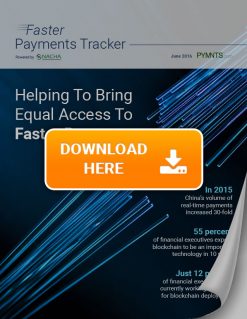Helping Bring Equal Access To Faster Payments

It’s happening. With the launch of Same Day ACH Phase 1 now just a little more than two months away, banks are getting ready for a payments future that’s faster – and forging partnerships to help them get there. July’s Faster Payments TrackerTM takes stock of the latest moves being made by two of the big guys, BNY Mellon and Chase, using clearXchange, as well as Treasury Software Director Glenn Fromer’s POV on the impact of Same Day ACH on banks and businesses.
It’s right around the corner and fast approaching – the first phase of Same Day ACH payments is set to launch just about two months from now.
While the ability to more rapidly send money to another bank account is expected to have a profound impact on consumers, businesses and banks alike, it’s currently affecting the latter entities most poignantly, as they’re in the midst of ramping up preparations for the fall. As businesses attempt to get their affairs in order by the start of Phase 1, banks are focused on meeting NACHA deadlines, establishing crucial cut-off times and gathering necessary data from their clients.
Between the businesses and the banks lies one significant pit stop on the road to faster payments: the ACH file. In order for companies to gain access to the capabilities of the high-speed electronic network – access that would help streamline operations like payroll and vendor payments – they must present their financial institution with an ACH file, a specially formatted document containing data that companies typically store in a CSV data file or Excel file.
While most massive corporations have internal accounting teams to create ACH files, many small to mid-size (and even large) organizations aren’t sure where to begin – or even what their banks are requesting.
That’s where software development houses, like Treasury Software, enter the picture. These players exist
to bridge the gaps between companies and their financial institutions through solutions that supplement accounting practices and launch businesses into the ACH Network. PYMNTS recently spoke with Glenn Fromer, ACH Product Manager, Director of Development at Treasury Software, to discuss his company’s role in the push toward faster payments and to get an inside look at what’s to come for Same Day ACH.
A key piece of the faster payments puzzle
Although Treasury Software’s primary service – creating ACH files – is a vital stepping stone on the faster payments pathway, its function doesn’t replace the business/bank relationship. Rather, they’re a third-party service intended to support and simplify the process of setting up Same Day ACH.
“Think of us more on the accounting side,” Fromer explained. “Think of us as a universal add-on. If a client is using QuickBooks, Peachtree [now Sage 50], or Great Plains, we’re working with their software. And it doesn’t have to be accounting software – if they have an SQL database, or a database of any kind, or if they simply have information in an Excel file or a CSV file, we can convert those data sets into an ACH file.”
Treasury Software operates outside of the client/bank bond, allowing companies to continue working with their preferred financial institutions and still maintain access to the electronic network.
If a business worked with U.S. Bank, he said as an example, “it would use our software to create the file, but the process is still U.S. Bank’s.” Treasury Software’s role is similar to that of private check manufacturers: While the company’s product can be used by clients and processed by banks, it doesn’t disturb the previously established ecosystem that exists between these entities.
What Treasury Software’s service does do is make client information readable by the ACH Network.
“The ACH file is very specifically formatted – it’s a plain text file, but it’s very specifically formatted,” Fromer explained.
If a business is making 200 transactions, he said, its ACH file would contain 200 lines – one line for every payment or collection. Each line includes information like an account number, a routing number, an amount and an accountholder’s name. When the file is uploaded by the bank, the payments can be sent and received via the ACH Network.
Bringing the benefits of Same-Day ACH to clients big and small
Fromer’s in-depth knowledge of the ACH Network supports his belief that the Network brings benefits to businesses of all sizes. His clientele ranges from mom-and-pop shops to Fortune 500 companies, but his goal remains the same across the board: to help bring businesses into the future of faster payments.
“One of our core beliefs is that it shouldn’t matter how big or small of a company you are, you should have access to the ACH Network,” Fromer said. “So, we want to make sure everyone has equal access.”
Aside from the obvious benefit – being able to pay and receive funds faster – there are an abundance of reasons why companies want access to Same Day ACH. For small businesses, which often perform accounting actions manually, automating payments through Same Day ACH can reduce the risk of fraud and error, explained Fromer. Additionally, Same Day ACH is expected to streamline processes in states that require businesses to pay terminated workers on the same day they’re let go.
From Phase 1, into the future
With the launch of the first phase of Same Day ACH set for Sept. 23, it’s crunch time for banks and businesses looking to integrate with the high-speed electronic network.
The first wave of same-day service will support ACH credit payments. Phase 2, launching next fall, will include both credits and debits. In both these stages, banks will have to provide availability to accounts by the end of their processing days. This deadline will switch to 5 o’clock local time once the final step, Phase 3, is enacted.
For Fromer and his team, whose adjustments for Phase 1 of same-day service were completed back in April, the next three months are the proverbial eye of the storm – an opportunity to reflect on current challenges and look forward to the future of faster payments.
Phase 1 obstacles, Fromer explained, are mainly being faced by banks – especially smaller branches with limited resources, who may find themselves understaffed during the transition. Fraud, however, is one issue that banks and software providers alike are keeping an eye on during the rollout of Same Day ACH. Fromer said that Treasury takes a multifaceted approach to digital security.
“What we’re looking at is fraud and security from the origination — in other words, through the file creation and the transmittal to the bank. We do have database encryption, we’ve got password protections, audit trails, backups, we have SQL server capabilities, separation of duties,” he explained. “We don’t just have one thing – it’s multilayered.”
Other bumps on the road to comprehensive Same Day ACH include a $25,000 limit and a lack of international transaction capabilities, he said. As faster payments become a reality, however, many financial players are developing other capabilities that could expand their monetary and geographical limits.
These hurdles, while valid long-term concerns, aren’t likely to mitigate the profound impact Same Day ACH is expected to have on the financial ecosystem, explained Fromer.
“[Same Day ACH] is going to be a slam dunk, home run; this is the next natural progression for ACH. This is going to be great,” he said. “I really feel that this is going to attract companies that may have gone elsewhere, bring them into the world of ACH.”
Looking down the road, Fromer expects the Network to grow in popularity as a result of same-day services. “This is definitely a winner,” he said.
To download the July edition of the PYMNTS.com Faster Payments Tracker™, powered by NACHA, click the button below.
About The Tracker
The PYMNTS Faster Payments Tracker™, powered by NACHA, is your go-to resource for staying up to date on a month-by-month basis. The tracker highlights the contribution of different stakeholders, including institutions and technology coming together to make this happen.

